

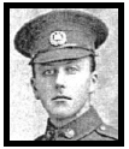
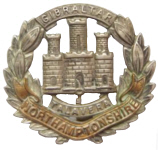
Second Lieutenant, Alfred Cecil Dudley PAGE
Aged 22
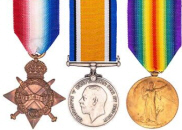
|
Alfred Cecil Dudley PAGE was born on 12th January 1894 (Wellingborough Q1-1894 3B:165), son of James and Elizabeth PAGE (née JOHNSON). Apparently recorded as Arthur or Alfred (the Army has Alfred) 1901 census...Aged 7, Arthur D PAGE was at "Nene View", Union Road, Wellingborough with his father James PAGE [51] linings and leather dresser, born Wellingborough; his mother Elizabeth [45] born Guilsborough; brothers James Percy Johnson [19] working for father, and Thomas B [11]; sisters Elsie R.J. [18] and Irene [14]. All the children were born in Wellingborough. 1911 census...Aged 17, an articled lawyer's clerk, he was at 4 Castle Street, Wellingborough with his parents, sister Ruth (Elsie) and brother Thomas Bertram (farmer's assistant). One of the 6 children had died. He was articled to Breks, Green & Stops, of Northampton before joining the Northamptonshire Regiment as a private on 15th September 1915. The school roll of honour identifies him and his regiment,
|

|
Weighing 145 lbs(66 kg), height
5 feet 10.5 inches (179.1 cm), chest 33.5" to 36.5" (85.1 to 92.7 cm), blue eyes, dark brown hair, a Congregationalist, he gave his next of
kin as father James, and mother Elizabeth of Nene View, Wellingborough and brother James Percy Johnson PAGE of 78 Stanley, Wellingborough.
He was promoted in the 7th Battalion to Lance Corporal on 7th December 1914, before being commissioned into the 5th Battalion on 21st April 1915. At that time he gave his address as L/Cpl 15611, Page, The Schooner Hotel, Southwich and declared he could ride, but not very well. His documents did not disclose a connection with East Anglian School but several sheets in the fold were loose, so it is quite possible the applicable pages have been lost. Posted to the 5th (Pioneer)Battalion, Northamptonshire Regiment in France, they were working on trenches at Crater A, near Sailly Labourse on 3rd April 1916 when he was wounded in the shoulder. Classed as not serious, via 33rd Casualty Clearing Station, he was admitted to 2 General Hospital, Le Havre on 9th , prior to evacuation per HMHS "Asturias" from Le Havre to Southampton. He recovered by 18th May and was ordered to join the 8th (Reserve) Battalion on the 19th May 1916, then followed another move across Battalions, to the 7th and return to France in July. He was killed in an attack on the Quarry in front of Guillemont on 18th August 1916. From 7th Battalion Northamptonshire Regiment, 1914-1919 by Hugh Basil King:- The objective assigned to the 7th Northamptons was a stone quarry on the western edge of the village of Guillemont. The 3rd Rifle Brigade, attacking on the left, were to take the station and the 13th Middlesex Regiment to attack on the south side of the village. It had been decided that this attack, unlike the majority of previous battles, should take place in the afternoon, and it was hoped thereby to surprise the enemy with a daylight assault. Shortly before midday on August 18th the zero hour was changed and various other alterations made in the operation orders, and the Commanding Officer (Lieutenant-Colonel Mobbs) decided to meet all O.C. companies in the support line. A deep T-trench was selected for this interview, and the Commanding Officer had barely outlined the new orders when a shell, striking the top of the trench, partially buried the occupants. On extricating themselves it was found that the Commanding Officer had been wounded in the shoulder-blade, and that his back was already stiffening, and it was feared that his spine had been affected. Captain H. Grierson (" A " Company) had been wounded and badly shaken ; the other officers, Captain R. Gurney and Captain H. B. King, had escaped without injury. Captain Grierson had to be evacuated, and Lieutenant-Colonel Mobbs, much against his will, had to be sent down the line, leaving Captain H. B. King to take command. Shortly before zero, however, Major Murphy (2nd Leinster Regiment) was sent to take command of the assault, arriving half an hour before zero. At 2.45 p.m. the barrage lifted and the battalion left their trenches. Until right up to the German front line very few casualties were suffered. It was then discovered that a trench, invisible from the British line, was held in strength. " A " and " C " Companies suffered heavily from this trench ; " B " Company in support formed the second wave of the attack, and with the assistance of the reserve company (" D ") succeeded in capturing the greater part of the objective. The attack on the flanks meanwhile had proceeded with varying success. That on the left, made by the 3rd Rifle Brigade, had taken its objective, and was in touch with the left of the battalion not far from two goods wagons that represented all that the bombardment had left of Guillemont Station. On the right, however, the 13th Middlesex Regiment, after reaching their first objective, had been cut down almost to a man by machine-gun fire from a strong point on their right that had so far resisted all assaults, and had been obliged to fall back almost to their original line, after leaving all four company commanders dead in the German line. The situation was now serious for the 7th Northamptons ; their right flank was in touch with no one. It was, however, essential to hold on to this position, and Major Murphy, after visiting the position, sent back for a section of machine gunners to be sent up. These machine gunners lost heavily on the way up, and it was not found possible to equip even one complete team from the survivors that arrived, and thus I the night of August 18th-19th was an exceedingly anxious one. Small parties of the enemy were seen throughout the night creeping towards the new line, but the battalion Lewis gunners were able to deal with them, and no counter-attack developed. At dusk next day the battalion was relieved by the 8th Royal West Kent Regiment, and returned to the old trenches near Montauban. Major Murphy rejoined his battalion as Commanding Officer, and Captain H. B. King resumed command. It was found that the casualties amounted to :- Officers : Killed, 5 ; wounded, 15 ; missing, 1. Other ranks : Killed, 45 ; wounded, 258 ; missing, 49. It transpired afterwards that nearly all those at first reported missing had really been killed or wounded. This was an obstacle that took more than 3 weeks to overcome, the defenders dug in on the east facing slope and therefore comparatively sheltered and able to emerge behind any British troops that may try to enter the village. The British kept to the same attack plan time after time, and time after time were defeated. |
photo from school archives - here before he was commissioned The quarry, actually an old gravel pit, is now mostly filled in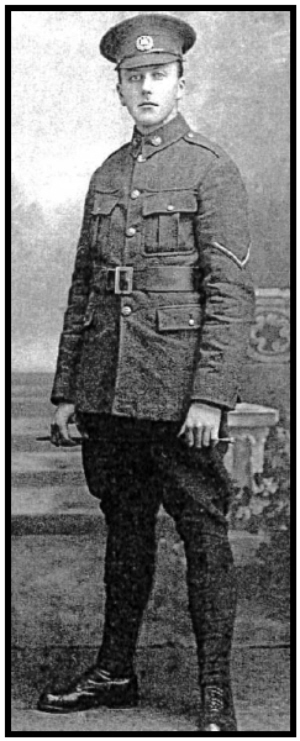
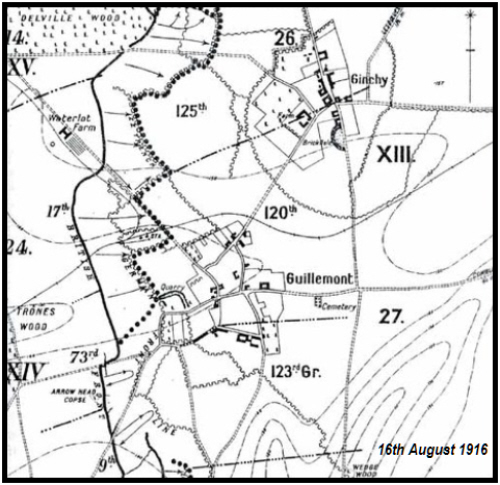
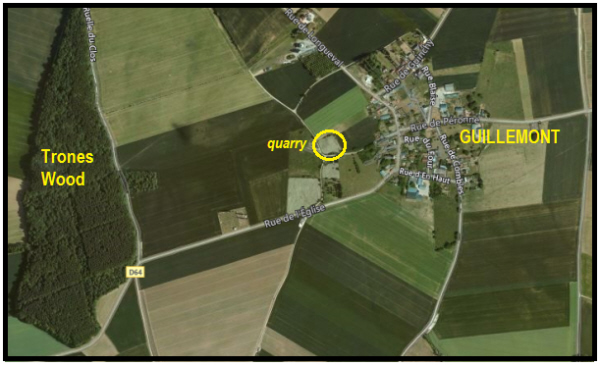
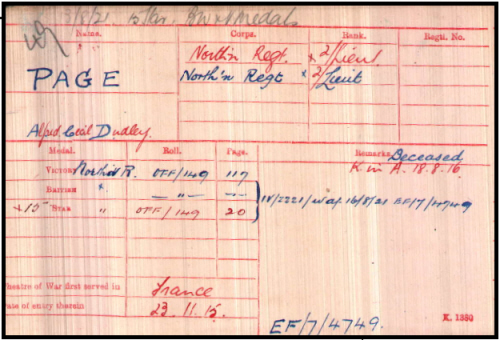
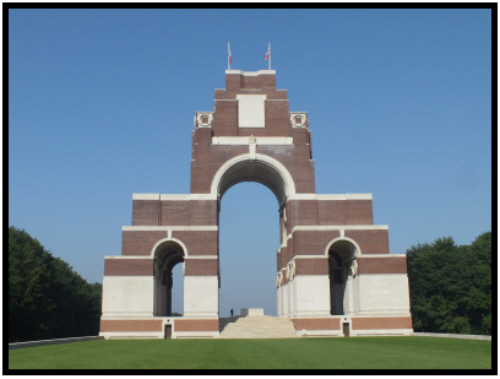
click here to go to the Commonwealth War Graves Commission website for full cemetery/memorial details